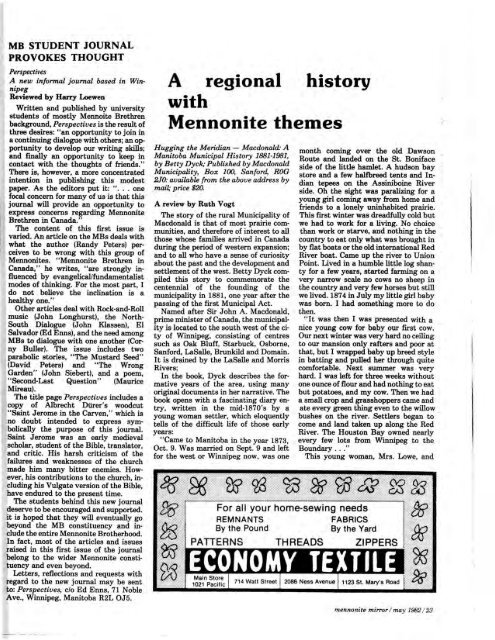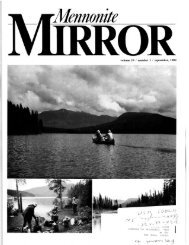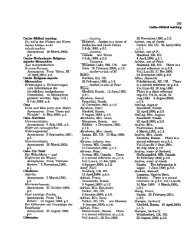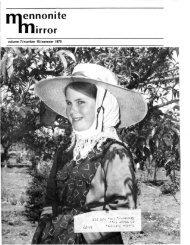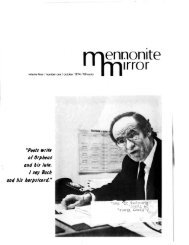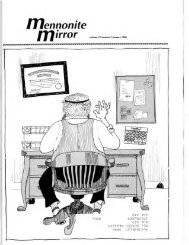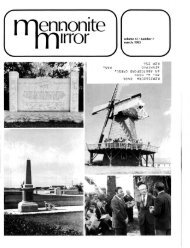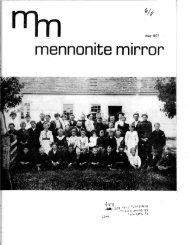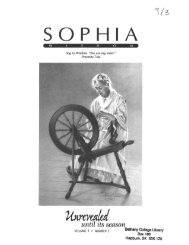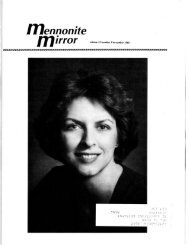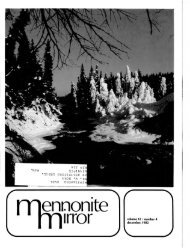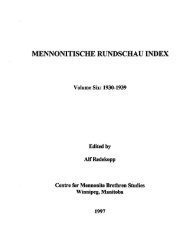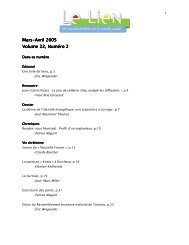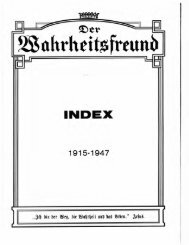Volume 11/ Number 9 - Canadian Conference of Mennonite ...
Volume 11/ Number 9 - Canadian Conference of Mennonite ...
Volume 11/ Number 9 - Canadian Conference of Mennonite ...
You also want an ePaper? Increase the reach of your titles
YUMPU automatically turns print PDFs into web optimized ePapers that Google loves.
MBSTUDENTJOURNAL<br />
PROVOKES THOUGHT<br />
Perspectives<br />
A new informal journal based in Winnipeg<br />
Reviewed by Harry Loewen<br />
Written and published by university<br />
students <strong>of</strong> mostly Mennoite Brethren<br />
background, Perspectives is the result <strong>of</strong><br />
three desires: "an opportunity to join in<br />
a continuing dialogue with others; an opportunity<br />
to develop our writing skills;<br />
and finally an opportunity to keep in<br />
contact with the thoughts <strong>of</strong> friends."<br />
There is, however, a more concentrated<br />
intention in publishing this modest<br />
paper. As the editors put it: " ... one<br />
focal concern for many <strong>of</strong> us is that this<br />
journal will provide an opportunity to<br />
express concerns regarding <strong>Mennonite</strong><br />
Brethren in Canada."<br />
The content <strong>of</strong> this first issue is<br />
varied. An article on the MBs deals with<br />
what the author (Randy Peters) perceivesto<br />
be wrong with this group <strong>of</strong><br />
<strong>Mennonite</strong>s. "<strong>Mennonite</strong> Brethren in<br />
Canada," he writes, "are strongly influenced<br />
by evangelical/fundamentalist<br />
modes <strong>of</strong> thinking. For the most part, I<br />
do not believe the inclination is a<br />
healthy one."<br />
Other articles deal with Rock-and-Roll<br />
music (John Longhurst), the North<br />
South Dialogue (John Klassen), EI<br />
Salvador (Ed Enns), and the need among<br />
MBs to dialogue with one another (Corny<br />
Buller). The issue includes two<br />
parabolic stories, "The Mustard Seed"<br />
(David Peters) and "The Wrong<br />
Garden" (John Siebert), and a poem,<br />
"Second-Last Question" (Maurice<br />
Mireau).<br />
The title page Perspectives includes a<br />
copy <strong>of</strong> Albrecht Durer's woodcut<br />
"Saint Jerome in the Carven," which is<br />
no doubt intended to express symbolically<br />
the purpose <strong>of</strong> this journal.<br />
Saint Jerome was an early medieval<br />
scholar, student <strong>of</strong> the Bible, translator,<br />
and critic. His harsh criticism <strong>of</strong> the<br />
failures and weaknesses <strong>of</strong> the church<br />
made him many bitter enemies. However,<br />
his contributions to the church, including<br />
his Vulgate version <strong>of</strong> the Bible,<br />
have endured to the present time.<br />
The students behind this new journal<br />
deserve to be encouraged and supported.<br />
it is hoped that they will eventually go<br />
beyond the MB constituency and include<br />
the entire <strong>Mennonite</strong> Brotherhood.<br />
In fact, most <strong>of</strong> the articles and issues<br />
raised in this first issue <strong>of</strong> the journal<br />
belong to the wider <strong>Mennonite</strong> constituency<br />
and even beyond.<br />
Letters, reflections and requests with<br />
regard to the new journal may be sent<br />
to: Perspectives, clo Ed Enns, 71 Noble<br />
Ave., Winnipeg, Manitoba R2L OJ5.<br />
A regional history<br />
with<br />
<strong>Mennonite</strong> themes<br />
Hugging the Meridian - Macdonald: A<br />
Manitoba Municipal History 1881-1981,<br />
by Betty Dyck; Published by Macdonald<br />
Municipality, Box 100, Sanford, ROG<br />
2./0: available from the above address by<br />
,mail; price $20.<br />
A review by Ruth Vogt<br />
The story <strong>of</strong> the rural Municipality <strong>of</strong><br />
Macdonald is that <strong>of</strong> most prairie communities,<br />
and therefore <strong>of</strong> interest to all<br />
those whose families arrived in Canada<br />
during the period <strong>of</strong> western expansion;<br />
and to all who have a sense <strong>of</strong> curiosity<br />
about the past and the development and<br />
settlement <strong>of</strong> the west. Betty Dyck compiled<br />
this story to commemorate the<br />
centennial <strong>of</strong> the founding <strong>of</strong> the<br />
municipality in 1881, one year after the<br />
passing <strong>of</strong> the first Municipal Act.<br />
Named after Sir John A. Macdonald,<br />
prime minister <strong>of</strong> Canada, the municipality<br />
is located to the south west <strong>of</strong> the ci-,<br />
ty <strong>of</strong> Winnipeg, consisting <strong>of</strong> centres<br />
such as Oak Bluff, Starbuck, Osborne,<br />
Sanford, LaSalle, Brunkild and Domain.<br />
I t is drained by the LaSalle and Morris<br />
Rivers;<br />
In the book, Dyck describes the formative<br />
years <strong>of</strong> the area, using many<br />
original documents in her narrative. The<br />
book opens with a fascinating diary entry,<br />
written in the mid-1870's by a<br />
young woman settler, which eloquently<br />
tells <strong>of</strong> the difficult life <strong>of</strong> those early<br />
years:<br />
"Came to Manitoba in the year 1873,<br />
Oct. 9. Was married on Sept. 9 and left<br />
for the west or Winnipeg now, was one<br />
month coming over the old Dawson<br />
Route and landed on the St. Boniface<br />
side <strong>of</strong> the little hamlet. A hudson bay<br />
store and a few halfbreed tents and Indian<br />
tepees on the Assiniboine River<br />
side. Oh the sight was paralizing for a<br />
young girl coming away from home and<br />
friends to a lonely uninhabited prairie.<br />
This first winter was dreadfully cold but<br />
we had to work for a living. No choice<br />
than work or starve, and nothing in the<br />
country to eat only what was brought in<br />
by flat boats or the old international Red<br />
River boat. Came up the river to Union<br />
Point. Lived in a humble little log shanty<br />
for a few years, started farming on a<br />
very narrow scale no cows no sheep in<br />
the country and very few horses but still<br />
we lived. 1874 in July my little girl baby<br />
was born. I had something more to do<br />
then.<br />
"It was then I was presented with a<br />
nice young cow for baby our first cow.<br />
Our next winter was very hard no ceiling<br />
to our mansion only rafters and poor at<br />
that, but I wrapped baby up breed style<br />
in batting and pulled her through quite<br />
comfortable. Next summer was very<br />
hard. I was left for three weeks without<br />
one ounce <strong>of</strong> flour and had nothing to eat<br />
but potatoes, and my cow. Then we had<br />
a small crop and grasshoppers came and .<br />
ate every green thing even to the willow .<br />
bushes on the river. Settlers began to<br />
come and land taken up along the Red<br />
River. The Houston Bay owned nearly<br />
every few lots from Winnipeg to the<br />
Boundary ... "<br />
This young woman, Mrs. Lowe, and<br />
mennonite mirror / may 1982 123


